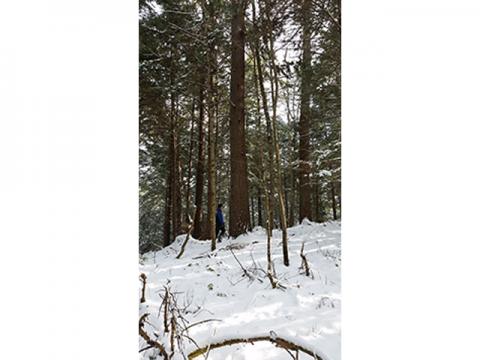Looking for the Eastern White Pine

When conducting site visits with landowners, I see many stands of pine trees. Some people refer to all evergreens as “pines," but here we’re talking about the Eastern White Pine, Latin name Pinus strobus. Some of the pine stands I walk through have health issues, including needle cast, Caliciopsis canker, blister rust, and white pine weevil. These various insects and diseases can cause poor growth, deformed trees, or mortality, decreasing the trees' health and value. Through research and trial and error, foresters continually develop ways to reduce the impact of these problems. Doing so is important because the white pine is a significant contributor to New Hampshire's forest economy.
White pines often tower over other trees in the woods, and they do the same in the economic and cultural history of New England. When the British first started to explore the region, the tall pines, with their large, straight trunks, were an attractive resource. The biggest and best pines were reserved for British navy ship masts, and were considered property of the king. A 1772 law declared all pines 12 inches in diameter and larger to be the king’s property. Settlers couldn’t cut any pines until a Deputy Surveyor of the King’s Woods marked the trees suitable for masts with a broad arrow. Then the landowner had to pay a substantial sum for a license to cut the remaining pines on his property. The Deputy Surveyor also had the right to inspect sawmills. Any logs that he felt were cut without a license he would mark with an arrow and prohibit the owner from sawing until a fine was paid. One of these instances led to the Pine Tree Riot of 1772 in Weare. Objections to laws governing the ownership of pines contributed as much to the start of the American Revolution as did disagreements over taxation and tea.
After America won its independence, white pine harvesting continued to provide lumber for building the new nation. In addition to shipbuilding, pine was used for sheathing, wainscoting, furniture, cabinetry, flooring, and molding. The wood was highly prized because the trees yielded lots of lumber and it was easy to work with. It was also easily carved into ship figureheads, mantels and doorways.
Logging the old growth pines coincided with much of the farmland clearing that was taking place. In areas less suited to agriculture, most pine within reasonable distance of streams was cut, since water was the primary mode of transportation. Gradually, the original stands of pine that were present when settlers first arrived were cut over and the pine resource dwindled.
Gradually though, the forests recovered. Following widespread abandonment of New Hampshire farmland after the Civil War, due to the discovery of more fertile soils in the Midwest and the opening of the Erie Canal, pines started to grow back. When farmland is abandoned, pines have an advantage over hardwoods in forest succession. Pines compete better in grass, and if there are still animals grazing, they prefer to browse hardwoods over conifers. When domestic animals leave, the pines then have a head start.
As the second growth stands matured, a thriving box making industry emerged, which used large amounts of white pine. Pine lumber was the most common material used to make shipping containers before corrugated cardboard replaced it in the 1930s.
The mature pine stands we see today originated in one of several ways. Old field abandonment was one way, and harvesting of second growth pine for box wood was another. A third way that many of today's older pine stands got their start was the Great Hurricane of 1938. This massive storm blew down an estimated 2.6 billion board feet of timber, including many of the last remaining pockets of old growth.
Many of the pine trees growing now aren’t the same quality as the old growth pine. Many of them got their start in open conditions, so grew lots of branches low on their trunks, or were attacked by pine weevil, which deforms trees, creating a “bushy” appearance. If a stand hasn't been thinned or pruned, they will contain a lot of low grade lumber due to black knots, which are caused by dead branches. When a pine's lower branches die in the dense shade of a closed canopy, they usually don’t shed on their own. After the log is sawn into lumber, a dead branch shows up as a loose, “black knot” in the board. “Red knots”, on the other hand, are from live branches, and are sound, solid wood in the board. They can be considered a visual defect, but they're not a structural defect, so red knot logs are worth more than black knot logs.
This isn't to say that large, high quality white pine only existed in pre-European settlement forests and can't be grown again. Growing high value pine requires the practice of silviculture, as seen in stands that are managed for quality. Developing these high quality trees involves growing them on the appropriate sites, giving them plenty of space and pruning the lower limbs early in the life of the tree.
The eastern white pine played an important role in the development of New Hampshire, New England, and the nation. Because of its utility and beauty, landowners, foresters, loggers, and others practice good stewardship to ensure that it continues to play an important role in our state's forest economy well into the future.
UNH Cooperative Extension is hosting a March 4 workshop in Hanover on the basics of forest management, harvesting, wildlife habitat, and forest products. There will be a particular focus on white pine and associated insects and diseases, and the products made from white pine. Learn more at www.nhwoods.org.
Sources:
Thirty-Eight: The Hurricane That Transformed New England, by Stephen Long, 2016. Yale University Press.
The Pine Tree Riot - Weare, NH, April 1772. Summarized by Betty Ann Sutton from History of the Town of Weare, New Hampshire. From www.nhptv.org

